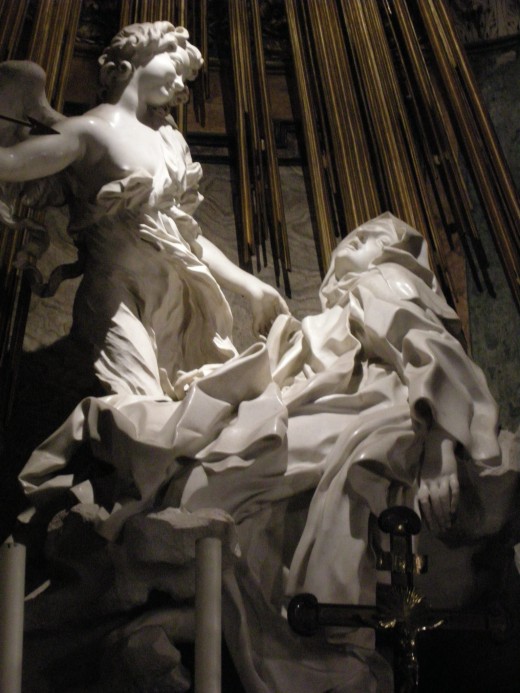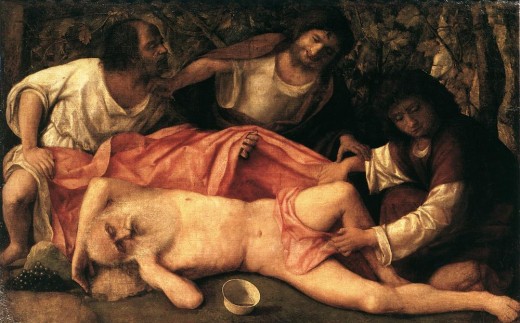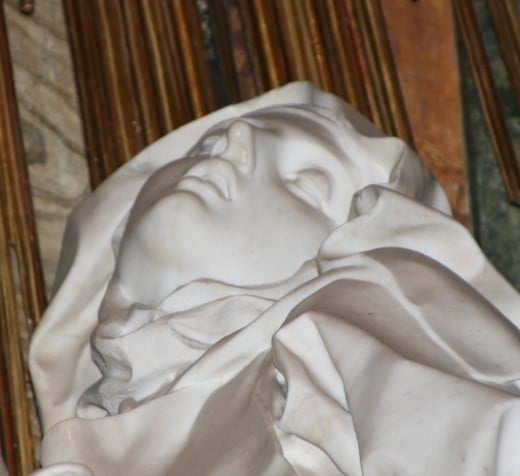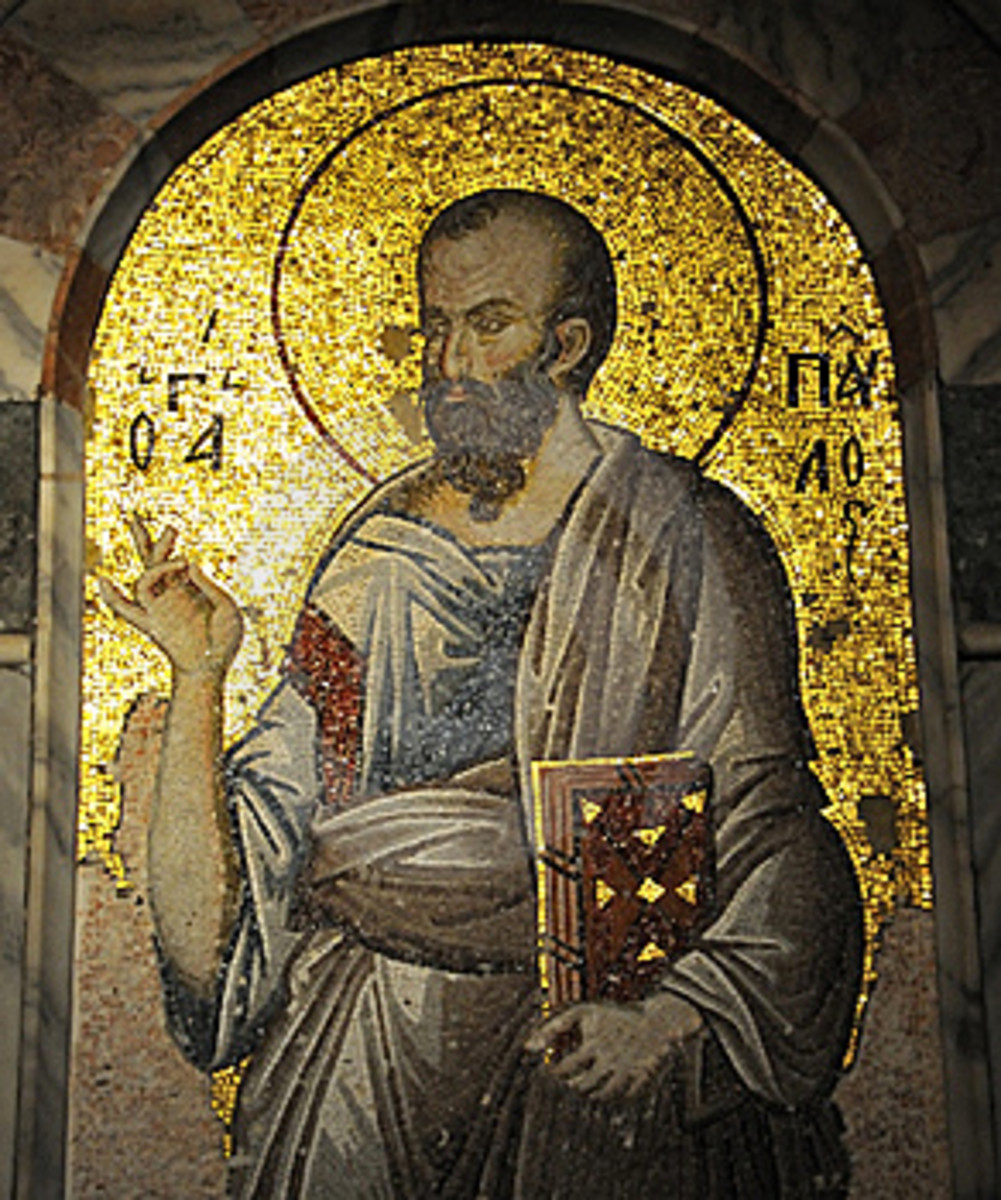A Justification for St. Theresa’s Portrayal

Given quasi-erotic undertones of Teresa of Ávila’s writings about her visions and the sexualized nature of Gian Lorenzo Bernini’s sculptural depiction of those visions in Ecstasy of St. Theresa, it is no wonder that both her texts and the sculptures have given post-Freudians (though certainly not just them) much to analyze and giggle over. Surely it must strike viewers as a bit shocking to see someone who is both a saint and a nun look as though her ecstasy is physical as well as spiritual. Whenever religion and sex meet they tend to create eyebrow-raising moments. Lacan argued, upon seeing the sculpture, that there was “no doubt about” the reading of the statue that suggests that St. Theresa’s experience is sexual (Mykyta 53). This essay will not attempt to refute that reading of the piece, rather to explain that, given the a historical perspective of forms of piety and an eye toward the practical, the sexual nature of this piece of art isn’t nearly as strange or scandalous as one might first assume. It is, in fact, completely appropriate to what Bernini was trying to accomplish.

It is very tempting to look at a piece like Ecstasy of St. Theresa and start making guesses about ulterior motives the artist might have had. It’s the kind of feeling that comes from seeing a repetition of scenes from the Bible or from classical mythology that are otherwise not very significant in a narrative sense aside from the fact that they involve nude figures. One starts to get the sneaking suspicion that the piece is just an excuse to investigate the human form. So a person viewing Ecstasy of St. Theresa without any sort of background information might assume that the scene itself was just a pretext to portray a woman orgasming since the viewing public might look askance at that sort of thing without a legitimate justification. But the fact of the matter is, far from cheap titillation, Bernini was a deeply devoted Catholic and saw his part in portraying the scene as, “not merely a problem in sculpture but an exercise in devotion” (Hibbard 137). Bernini practiced St. Ignatius’s Spiritual Exercises which “[urge] us to picture each religious event in its setting and to conjure up the image of the holy person in order to converse with it” (Hibbard 138). The sexual undertones are present, but they are not the point of the piece. The point is for viewers to reflect on a heavenly vision and in doing so experience visions of their own.
Authenticity, therefore, becomes incredibly important to this piece’s success. St. Theresa described her visionary experience by saying that:
Beside me, on the left, appeared an angel in bodily form.... He was not tall but short, and very beautiful; and his face was so aflame that he appeared to be one of the highest rank of angels, who seem to be all on fire.... In his hands I saw a great golden spear, and at the iron tip there appeared to be a point of fire. This he plunged into my heart several times so that it penetrated to my entrails. When he pulled it out I felt that he took them with it, and left me utterly consumed by the great love of God. The pain was so severe that it made me utter several moans. The sweetness caused by this intense pain is so extreme that one cannot possibly wish it to cease, nor is one's soul content with anything but God. This is not a physical but a spiritual pain, though the body has some share in it—even a considerable share. (Zucker, Harris)
As Dr. Steven Zucker and Dr. Beth Harris note, “Saint Teresa describes her intensely spiritual experience in very physical, even sexual terms.” Bernini, in an attempt to bring the true moment to light, does not shy away from the physicality that St. Theresa describes. He goes out of his way to portray the scene as she tells it.


“Scene” is a very apt word for this sculptural piece. Bernini was “dubbed ‘theatrical’ by unfriendly critics of a later period” but perhaps this shouldn’t be taken as the insult it was intended as (Hibbard 135). The piece is lavish in its attention to detail and its heavenly atmosphere—shown off by elements such as the cloud St. Theresa is reclined upon and or the golden rays of light behind the angel. The overwhelming quality of this atmosphere shouldn’t be surprising considering that “in [Bernini’s] actual works for the theatre he tried to make stage effects as ‘real’ as possible in order to intensify the dramatic impact. We read of an actual fire on stage, of a realistic sunrise, and of a staged flood seeming to threaten the audience” (Hibbard 135). As a result of this very complete setting, the viewer is completely immersed in the fantastical scene. This all serves the greater purpose of making the viewer connect with this very special and rare moment.
This, of course, brings us back to the sexual connotations of the piece. It too helps the viewer to connect with the piece. After all, heavenly visions are not commonplace and very few have experienced the divine love that St. Theresa experienced. Bernini was therefore “conscious of [his] mission as [teacher], and it is worth repeating that [he] spoke in terms understandable to ordinary men” (Wallace 145). Perhaps ordinary people could not comprehend godly ecstasy, but they could understand physical ecstasy. By going that route, Bernini created a high-concept piece that could speak to the concerns and experiences of everyday people.
What’s more, the sexual overtones make a great deal of sense in serving the overarching idea of the piece, i.e.: a union between heaven (the angel) and earth (St. Theresa). We can see this meeting of forces as a major concern in the piece in its layout. The bas-relief on the front of the altar shows “the Last Supper, at which, through the mystical institution of Communion, men were joined to Christ” (Wallace 146).
Indeed, the Bible itself is full of metaphors that mix married life with religion. The church is seen as the bride of Christ. One passage from the Bible encourages gladness that “the marriage of the Lamb is come, and his wife hath made herself ready” (King James Version, Revelation 19:7). It may seem a little strange to some, but framing the relationship between the heavenly realms and the earthly realms in sexual terms is really only pushing harder at this very old metaphor.
Far from being shocking, St. Theresa’s experience (and, as a result, Bernini’s portrayal of that experience) not only builds on the Biblical language of the relationship between Christ and humans, but can trace itself back to modes of Christianity present in the late Middle Ages when an emphasis on Christ as, not only God and King, but as man was very prominent. This created a new, more personal way to relate to Christ as followers could empathetically feel pain for Christ (as St. Theresa feels the pain of the golden spear). This is especially important in leading up to St. Theresa’s case because, through this mode of worship, women gained a greater role in religious activity. These women “who had been excluded from the Latin-based, textural traditions of theology, discovered fertile ground in this tradition of so-called ‘affective,’ or emotional, piety. Through such emotive imagining, one gained an apparently unmediated and potentially authoritative, relation with Christ” (Christ’s Humanity 356).

One such woman from before St. Theresa’s time was Margery Kempe. Like St. Theresa, Margery experienced visions and “often painful psychological and bodily experiences” (The Book of Margery Kempe). Margery’s position was a bit more precarious than St. Theresa’s because she was not a nun, but a married woman claiming to have been chosen by God, and therefore she created a bit of a fuss. The matter was further complicated by the “sometimes erotic” quality of her visions of Christ and angels—another thing she shared with St. Theresa (The Book of Margery Kemp). Both women are part of a tradition of female mystics who negotiated religion alongside sexuality.
The sexual quality of the portrayal of St. Theresa by Bernini, therefore, has much to support its existence. It comes from a tradition of affective piety and mysticism and the reason for it can be seen in the language of the Bible itself. It was a valuable teaching tool to convey the wonders of heaven to a mass of people without a vast theological education and in ways that they could understand. It was part of an effort to both enshrine and encourage—concretize and animate—the practice of visionary connection with God. Bernini used every inch of the space he had available to submerge the spectator in the moment in the most authentic way possible so that that person could live that moment in his own life. The tremendous value of this work was felt in a very real way by Bernini. “I feel a special satisfaction at the bottom of my heart for this one work of architecture, and I often come here to console myself,” Bernini explained to his son upon finding him alone in the church (Wallace 146). For the artist as well as the viewers, the piece meant a climactic moment of connection between heaven and earth.

References
Hibbard, Howard. Bernini. London: Penguin, 1965. Print.
The Holy Bible, King James Version. New York: Oxford Edition: 1769; King James Bible Online, 2008. Web. 2 Mar. 2013.
Mykyta, Larysa. “Lacan, Literature and the Look: Women in the Eye of Psychoanalysis.” SubStance, 1983: 53. JSTOR. Web. 2 Mar. 2013.
Wallace, Robert. The World of Bernini: 1598-1680. New York: Time-Life Books, 1970. Print.
Zucker, Steven and Beth Harris. “Bernini’s Ecstasy of St. Teresa.” Smarthistory. Khan Academy. Web. 2 Mar. 2013.
Kempe, Margery. The Book of Margery Kempe, 1436, Ed. W. Butler-Bowdon, with an Introduction by RW Chambers. London: Jonathan Cape, 1936.







